
The first Russian settlement at the location of today’s city of Irkutsk was in 1661 when the Russian pioneer Yakov Pokhabov, led by Tungus (native Siberian) guides, erected his small wooden fort (called an ostrog) on the eastern banks of the Angara River opposite the mouth of the Irkut River.
Pokhabov, a Cossack, was tasked with exploring southern Siberia and the easiest way to get the job done was via the rivers.
Irkutsk dates back to the late 17th century when the first fortress was erected
Upon arrival, he met with the local indigenous Evenk people, native Siberians belonging to a Mongol ethnic clan. He decided to call the river “Irkut”, meaning “fast-flowing waters” in the Evenk language, although some people claim that the name Irkut was derived from the Buryat word for “spinning” (likely the spinning of the flowing river). At the time of his arrival, these rivers were much larger and stronger-flowing than what we can see today.

Pokhabov’s new fort, which he named Irkutsk, stood for just eight years before it was demolished. In its place, a much larger fortress was built which became known as the Irkutsk Kremlin. Seventeen years later, in 1686, the settlement of Irkutsk was awarded city status.
During the 18th century the city grew fast, though occasionally hampered by fires which all too frequently destroyed the wooden buildings. One of the most destructive fires raged in 1879, at which time Irkutsk had become a place of exile for the rebels who resisted the autocracy of the Russian Tsar. The fire destroyed almost the entire historical centre of the city. So significant was it, that people subsequently talked about Irkutsk’s history “before the fire” and “after the fire”. Even the wooden Irkutsk Kremlin was mostly destroyed and later demolished.
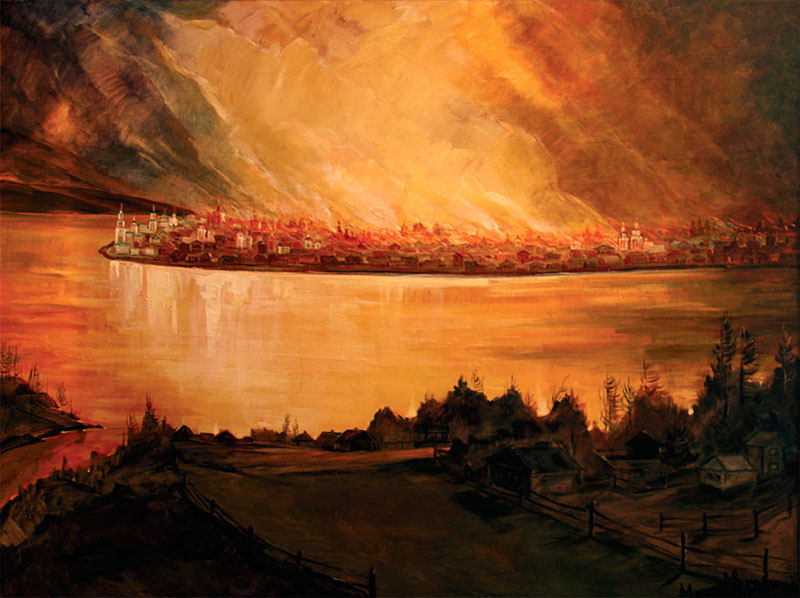
Of great importance to the city was the arrival of the Trans-Siberian Railway line in 1898 which markedly boosted the city’s status as a major centre for trade between Russia and China, and brought in much wealth.
Unfortunately, the wealth brought in through trade was not shared by all and the division between the rich and the poor was clearly visible by the beginning of the 20th century. This led to massive worker strikes in 1903 and again in 1905. After the newly formed Soviet Union tried to control the city in 1919-1920, bloody battles followed. The Bolsheviks of Lenin regained control in 1920 soon after the Red Army firmly established Soviet power in Irkutsk.
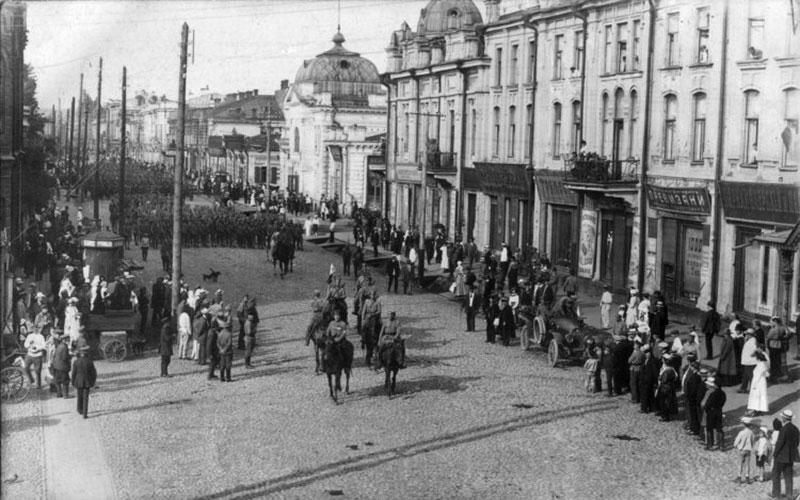
The Second World War recruited about 20,000 Irkutsk residents, with less than half of them surviving.
By the 1990s the city had become the industrial centre of Siberia and while today it remains the region’s industrial centre, the beauty of nearby Lake Baikal and the mountains have developed the area into a tourist hotspot. Russians from all over the country come to Irkutsk to enjoy the lake, its islands, the mountains, hot springs, and the Siberian cuisine.
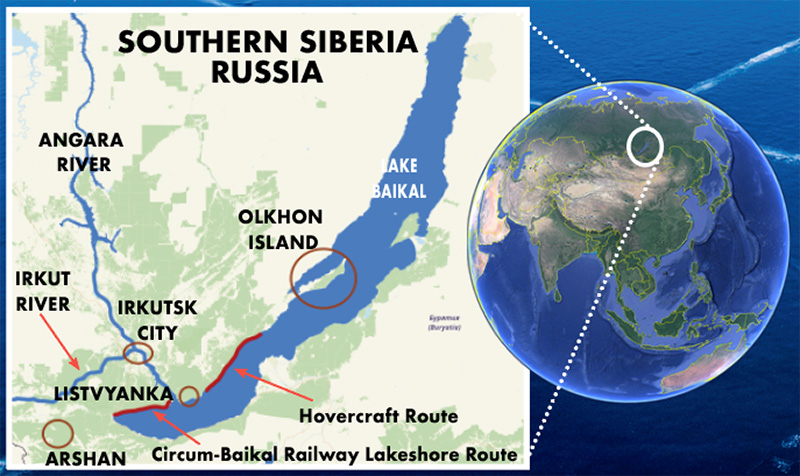
Why Travel to Irkutsk?
- The low-down: Irkutsk is the gateway to Lake Baikal, which is the biggest draw in the region, especially in winter when the frozen lake is spectacular. However, Irkutsk itself is an interesting town with lots of attractions, and serves as a great base from where to explore the region in all directions.
- The brightest highlight: The many old and spectacular domed orthodox churches are the highlight of Irkutsk, in particular the Kazansky Church (Church of Our Lady of Kazan).
- Intrepid destination: While the city itself gets its fair share of tourists, mostly from Russia but also from China, there are so many off-the-beaten-track hiking trails and villages to explore.
- Globerovers score (10 is highest): I truly enjoyed Irkutsk, even when I visited in January, mid winter, when the day temperatures hovered around -20C. The food and vodka, churches, parks, museums, and the walks along the shores of the Angara River flowing through the city. Irkutsk gets a score of 9/10.
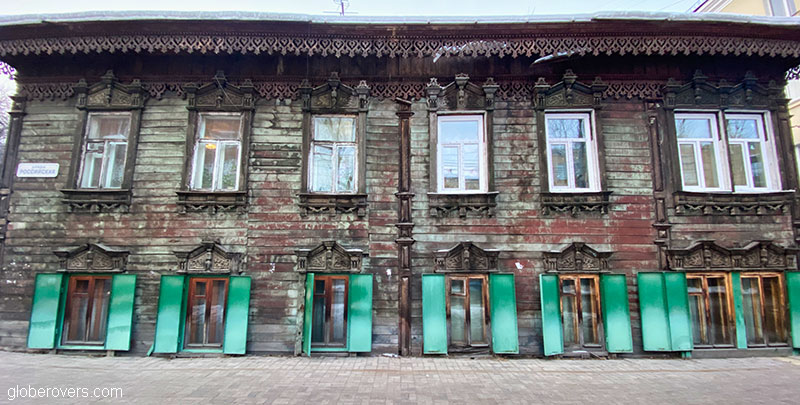
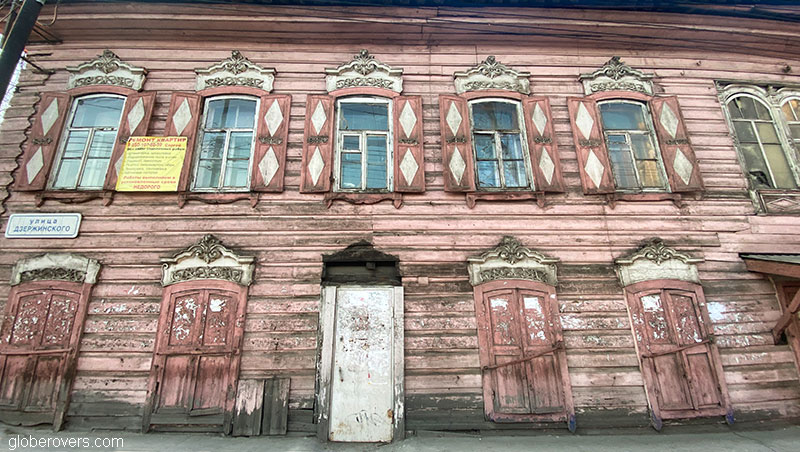
Table of Contents
The People of Irkutsk
Modern-day Irkutsk is a multi-ethnic city with over 600,000 residents. Located at the cross-roads between Mongolia, China, and Russia, it has been a hub of cultural exchange for centuries.
While these cultural exchanges all but disappeared while China was under the oppressive rule of Mao Zedong, it flourished under the subsequent leadership of Deng Xiaoping when the inhabitants of poorer Chinese provinces would travel to Irkutsk to trade at the markets. Today Chinese middle-class tourists are taking the region by storm, bringing in much needed foreign currency.
Modern-day Irkutsk is a melting pot of people from across the region
The current population of Irkutsk and its surrounding land is mostly comprised of ethnic Russians with a few native tribal groups. Russians and other Slavic/Germanic groups make up 93.5% of the population, while Buryats account for about 3.3%. Other minority groups include Soyots and Evenks, as well as Tofalars (Tofs) who developed from the intermingling of various clans of Turkic, Mongolic, Yeniseian and Samoyedic origins.
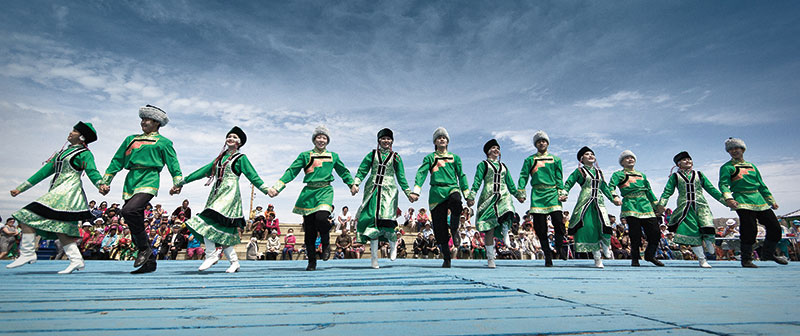
The Buryat ethnic group, the largest cohesive entity among the native groups, is descended from Mongolians who settled in the Lake Baikal area after the 12th century, and possibly even earlier. In search of green pastures for their sheep, they joined the indigenous Evenks and Tunguts.
The majority of the Buryat population now live in their homeland, the Republic of Buryatia, a federal subject of Russia near Lake Baikal. The republic today has a population of over 970,000 people, with Ulan-Ude as its capital. Their land stretches from beyond the lake’s northern tip, all along the eastern shore, well past the southern tip of the lake, and west to the slopes of the Sayan and Altai Mountains.

While Buryats share many customs with other Mongols, including nomadic herding and erecting gers for shelter, today most of them live in wooden houses, similar to the Russians. Those in the countryside still live a more traditional lifestyle.
They speak a central Mongolic language called Buryat, and like the Mongols, have adopted the Cyrillic alphabet. While the Buryats and Mongols can understand each other, their language is markedly different from the Russian language.
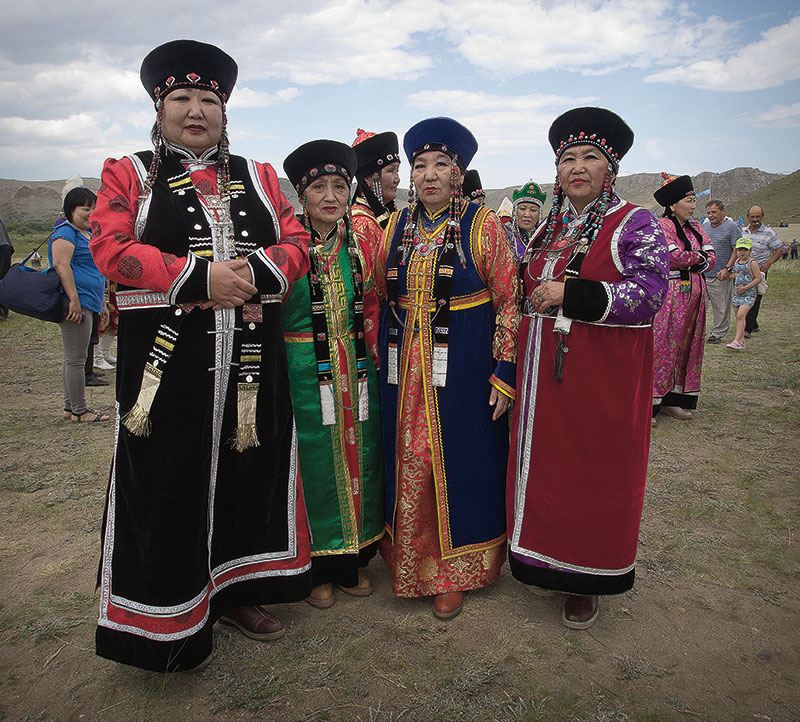
Buryats have traditionally practised shamanism, with a focus on the worship of nature. Today, faith in the Republic of Buryatia is divided between Russian Orthodoxy, the Tibetan branch of Buddhism, and the non-religious.
Shamanism has undergone a revival in rural areas since Soviet repression, however, it is still not widely practiced. Once a year during the summer, shamans gather on Olkhon Island for the International Shamanic Conference and Tailgan.


Above photos of the Buryat people provided by Alexey Trofimov: Photographer, Traveller, and Photoguide of Lake Baikal and the rest of Siberia.
View our post on the photography of Alex
Attractions of Irkutsk
Irkutsk is a year-round destination with enough activities available to keep even the most seasoned travellers occupied for several days.
While the daily mean temperature in summer (May to August) hovers around 20 degrees Celsius (68°F), in the middle of winter (December, January and February) temperatures can plummet to well below minus 20 degrees Celsius (-4°F).
Irkutsk city and the surrounding areas are packed with many attractions
Most visitors in winter come here to explore frozen Lake Baikal as well as the nearby hot springs and snow-covered mountains. But the best time to explore the city is during the warmer months.
The city is known for its imposing Orthodox churches, but it also offers a variety of history and art museums, galleries, historical houses, gardens and squares, a bustling central market, as well as several statues and monuments.

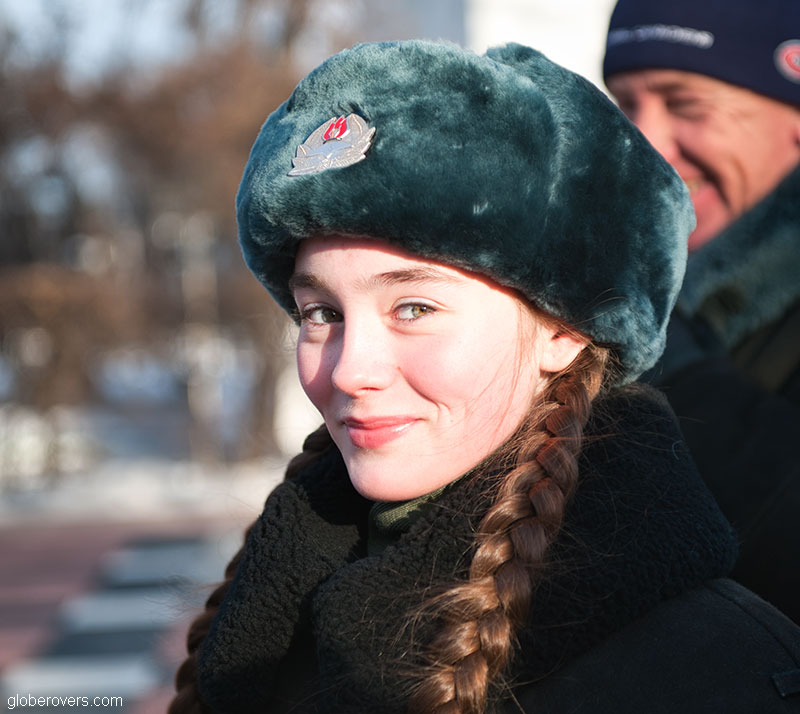
Historical Wooden Houses
Over the years, the city has maintained many of its historical buildings among those that were not destroyed by the fires. Look out for the neoclassical nobleman houses among the many colourful two-storey wooden houses.
Many of these houses were built in the 19th century by exiled intellectuals who flocked to the city after their revolt against Tsar Nicholas I. They brought with them a delicate taste for art and architecture.
While most of these houses are now privately owned and home to residents, a few are open to the public. Among the most notable are the Sukhachev Manor, the Volkonsky Manor, and the Trubetskoy Manor.
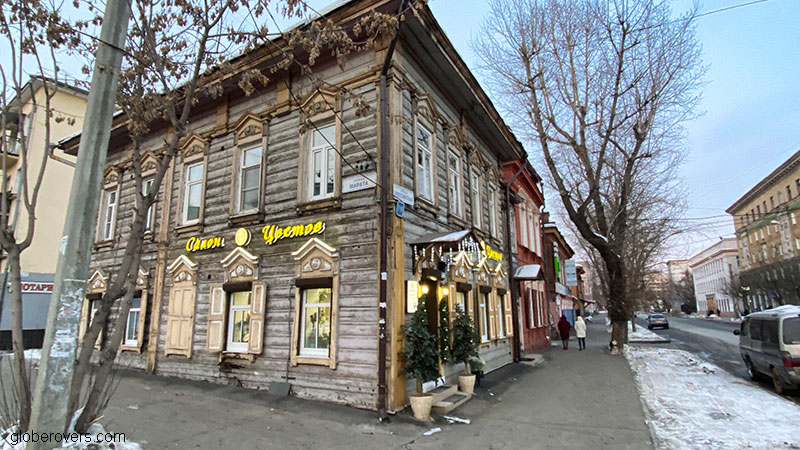
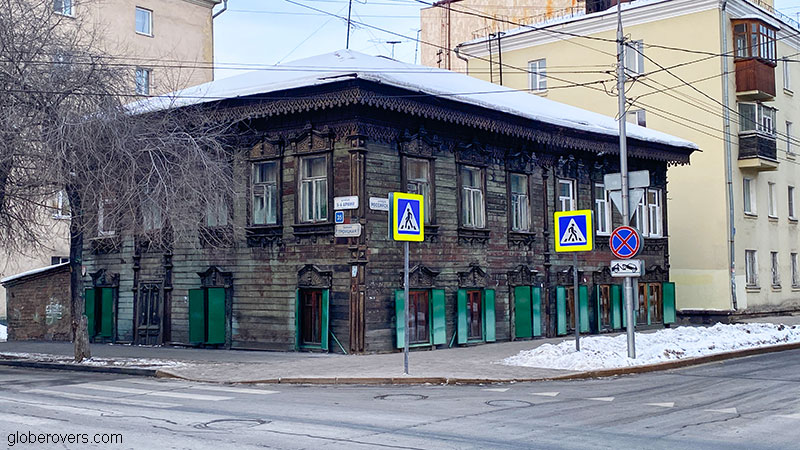
Religious Buildings
The histories of Irkutsk and Orthodoxy are inextricably linked to the city’s Cossack founders who arrived here in the 17th century.
They brought with them Orthodox icons, banners, crosses, and prayer books. They immediately built chapels and humble shrines, then later temples and elaborate Orthodox cathedrals: first wooden, then stone.
After the revolution, most of the religious buildings were confiscated by the Soviets. Many were destroyed or damaged beyond recognition and some were used as workers’ hostels, warehouses, and for a variety of other purposes.
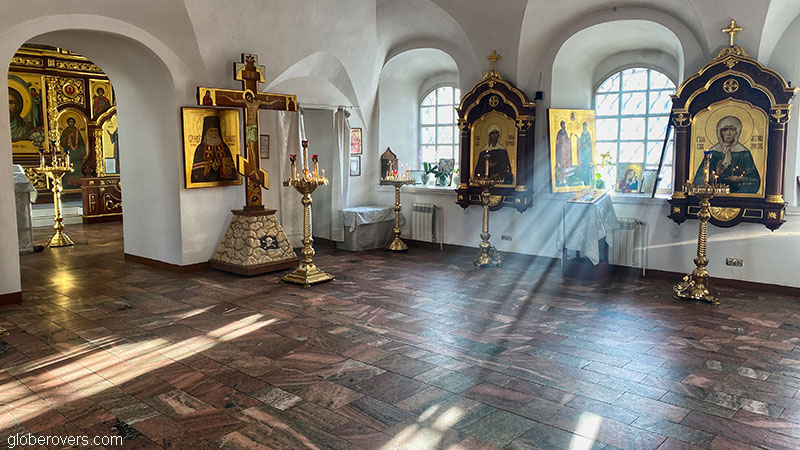
Eventually, the Soviet authorities returned some buildings in Irkutsk to restore the national spirit. Donations from believers went to the restoration and also the construction of new churches, shrines and chapels. At the end of the period of persecution, the services were reinstated and during the early 1990s people began to be baptized in droves.
Today’s Irkutsk is proudly home to many glorious religious buildings attesting to its rich past and present.
1) Spasskaya Tserkov
Located in the historic part of Irkutsk close to Memorial Park and its eternal flame, is the Spasskaya Tserkov (Church of the Saviour). The first building was a wooden church that existed until 1716, when a fire destroyed it.
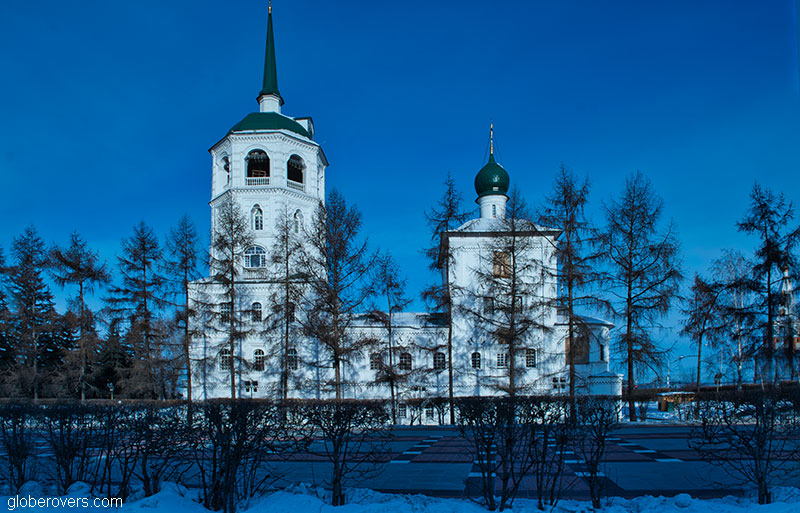
From the ashes of the wooden church, a new stone building arose with the help of wealthy residents. Over the centuries the stone church has endured several onslaughts such as fires, earthquakes, and long years of neglect and devastation under Soviet rule.
Next to the church in the Cathedral Square is a small chapel. Under the chapel is a crypt in the shape of a dodecahedron (with twelve flat sides) which is three metres (10 ft) high. The crypt’s concrete racks contain the remains of some of the city’s first inhabitants which were found during church repair works between 2008 and 2011.
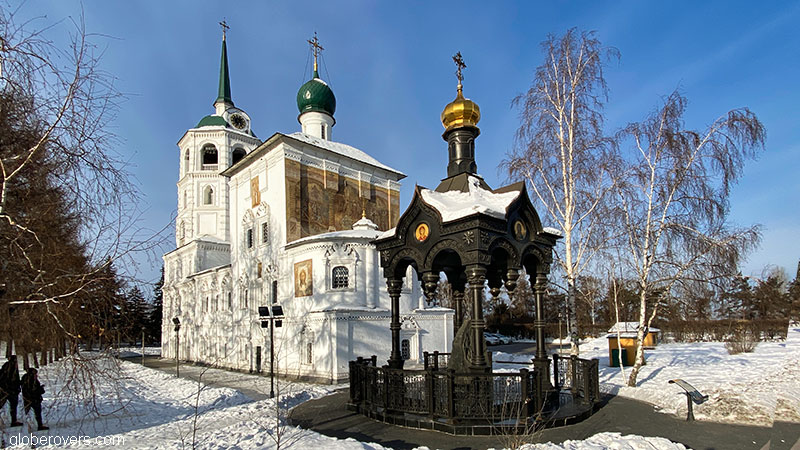
2) Sobor Bogoyavlensky Cathedral
Located on the banks of the Angara River and across the street from the Spasskaya Tserkov, is the Bogoyavlensky Cathedral. Also known as the Epiphany Cathedral, it has one of the most expressive architectural styles of all the monuments in Irkutsk. The original wooden structure was built in 1693 but was destroyed in the same fire of 1716 which consumed the Spasskaya Tserkov across the street. Two years after the fire, the construction of a stone church began which was eventually completed 13 years later.
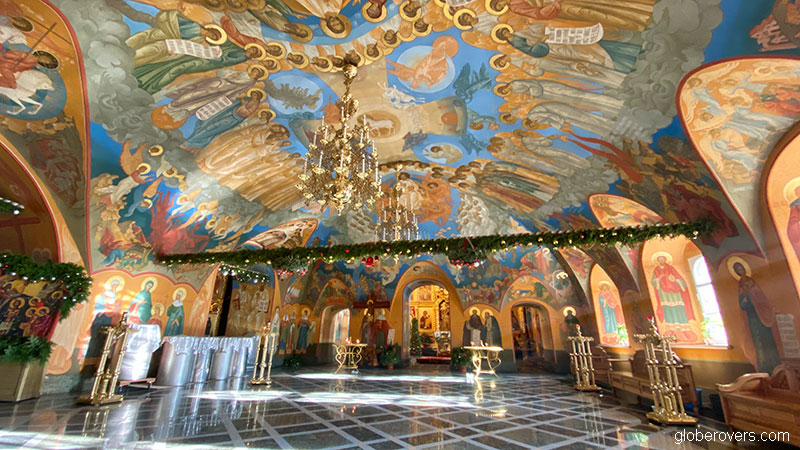
The new church stood for about half a century until it was severely damaged by an earthquake. The quake destroyed the bell tower and cracked one of the domes which was later removed.
Under Soviet rule, all divine services were halted in 1934 and the cathedral was forced to close its doors. The building remained shut until the 1980s when restoration started. The newly restored building is famous for its facades that are decorated with multi-coloured glazed tiles adorned with images of Biblical characters, flowers and mythical animals. Its bell, which dates back to 1797, weighs more than 12 tonnes (13 US tons).
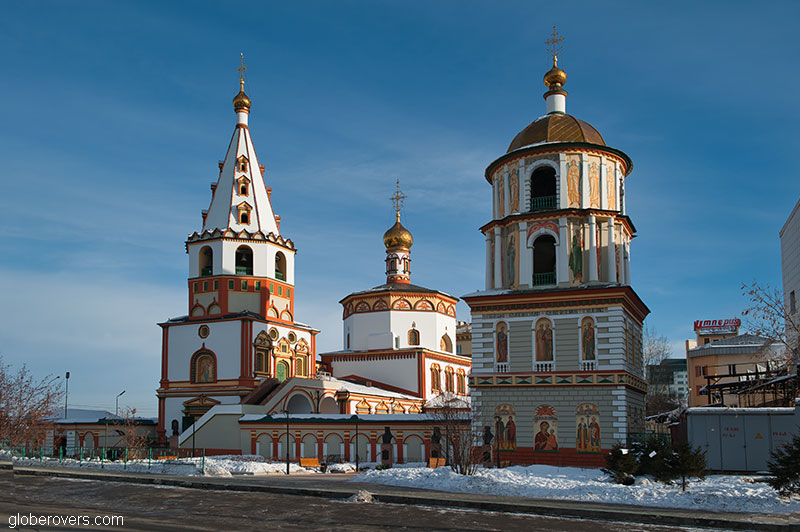
3) The Roman Catholic Church
In the same vicinity as the Spasskaya Tserkov and the Bogoyavlensky Cathedral is a neo-Gothic-styled Polish-built church known as the Church of Our Lady of the Assumption. The original building on this site was a small wooden church built in 1825 by a handful of Irkutsk’s Catholic settlers—probably no more than 300 souls. It was enlarged in 1855 but burned down during another large city fire in July 1879.
A new brick building was built by the Polish community, which they dedicated to the Assumption of the Virgin Mary. The cathedral has a magnificent interior with arches, carved wood, lacquered benches, and a harmonium (small organ) imported from the USA in 1896. The Soviets closed the church in 1938. Since 1978 the building has been used as the Organ Hall of the Irkutsk Philharmonic Orchestra.
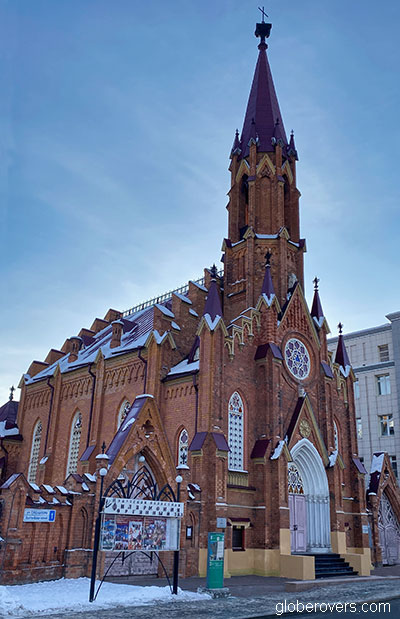
4) Kazansky Church
Located about three kilometres (1.9 mi) east of the historical centre across the Reku Ushakovka River, is one of the most beautiful churches in Irkutsk. The Kazansky Church is also known as the Kazan Church and the Church of Our Lady of Kazan.
Its salmon-pink walls and fluoro-turquoise domes topped with gold bauble-like crosses are spectacular.
Construction of the church started in 1885 and lasted for seven years. In 1936 it suffered the same fate as many churches of Russia as it was closed to church services and used for many purposes such as warehousing which significantly damaged the interior.
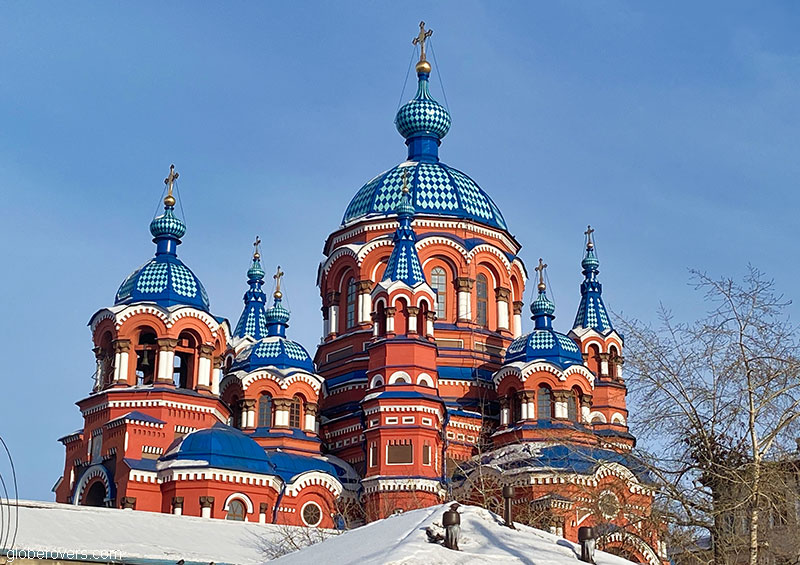
In the late 1980s some restorations were initiated though most renovation works took place between 1990 and 2012. Today the church, with its Byzantine style decorations, resembles a fairy palace. It is known for having Irkutsk’s largest church bell.
The interior is decorated with elaborate fresco paintings. Its unique iconostasis (a wall of icons and religious paintings) was carved out of Indian granite by Chinese craftsmen, weighs 70 tonnes (77 US tons), and stands 13 metres (43 ft) high.

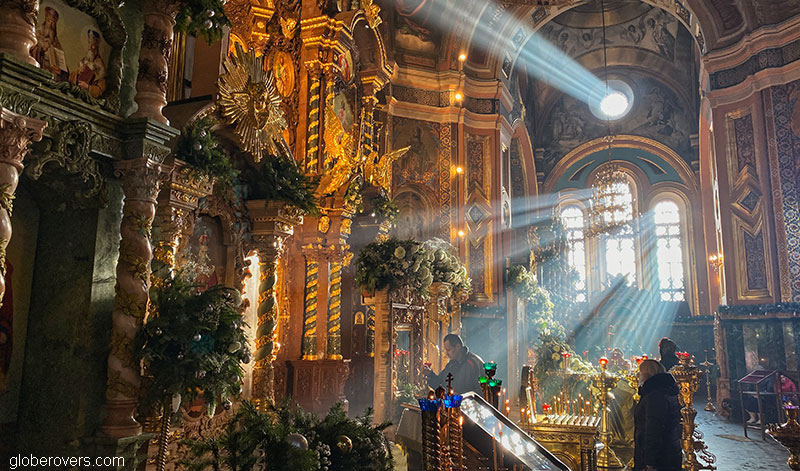
5) Archangel Michael Church
Located 1.4 kilometres (0.87 mi) south of Memorial Park is the Archangel Michael Church of Kharlampy. The church is also locally referred to as the “Sea Church” even though Irkutsk is about 2,000 kilometres (1,243 mi) away from Russia’s east coast.
As Irkutsk was once the largest city to Russia’s east coast, many sea voyages began here. Before starting the long overland journey to the coast, sailors first visited this church to get blessings for their expedition and hence it was referred to as the “Sea Church”.

The church is famous for being the place where Admiral Alexander Kolchak, who became the Supreme Ruler of Russia in the 1918-1919 time frame, got married on March 5th, 1904 while he was a young lieutenant in the Imperial Navy. Less than 16 years after his marriage, Admiral Kolchak was executed by the Bolsheviks who summarily dumped his body into the Ushakovka, a little rivulet of the Angara River.
6) Krestovozdvizhenskaya Tserkov
Further south of the historic city, close to the trendy area referred to as 130 Kvartal, is the Exaltation of the Holy Cross Church, locally known as Krestovozdvizhenskaya Tserkov.
The church is one of the oldest of Irkutsk’s Orthodox churches and a distinctive landmark of Siberian Baroque style.
Construction of the church started in 1747 and was completed by the end of 1760. The building was the crown masterpiece of the Siberian baroque style which has been taught at the local school of architecture since the mid 18th century.
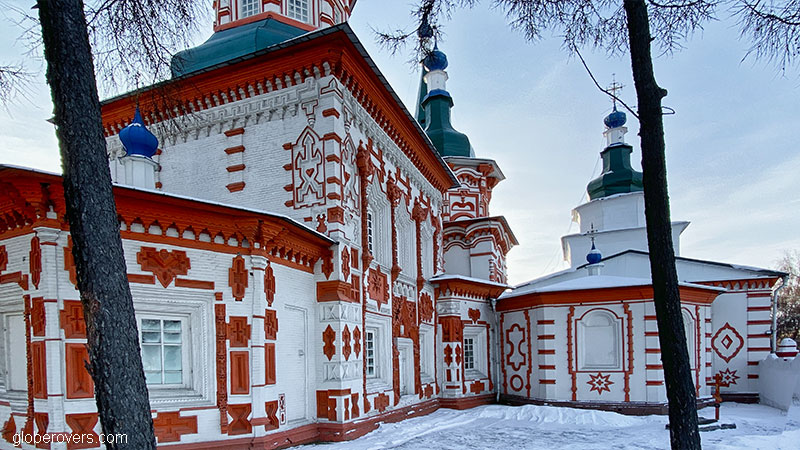
Situated on a small hill close to the intersection of the city’s main streets, the church remains a dominant feature.
It is famous for its unique exterior design and its facades decorated with rich ornaments influenced by local folk art.
Other places of worship worth visiting are the Znamensky Monastery, Prince Vladimir’s Church, Irkutsk Synagogue, and the Irkutsk Cathedral Mosque.

Museums and the Fine Arts
Irkutsk, as one of the largest cities in Siberia, is the cultural centre of the region with no shortage of museums, galleries, and theatrical performances.
The city has well over 30 museums. Among the more quirky museums are the Museum of the Passenger Car Depot, the Moto Retro Techniques Museum, Museum of Hunting, Museum of Optics and Optical Illusions, and the Museum of Medicinal Herbs and Minerals.
There are several art galleries around town. The Irkutsk Museum of Fine Arts holds the biggest collection of art in the whole of Siberia. It includes paintings, sculptures and icons, but most importantly, a collection of folk art from the indigenous peoples of the area.
The Irkutsk Philharmonic Orchestra was founded in the 1850s. Since October 1950 concerts have taken place in the Concert Hall of the Philharmonic Hall. Besides the Concert Hall there is an Organ Hall that was opened in 1978 in the building of the Polish Roman Catholic Church.
The Central Market
A perfect start to exploring Irkutsk is to spend an early morning at its well-maintained authentic central market.
This is a great place to find local delicacies such as taiga herbs, cedar nuts, fruits and berries, home-made jams, fruit- (or herb) infused liquors, cold meats, and several endemic species of Siberian fish.
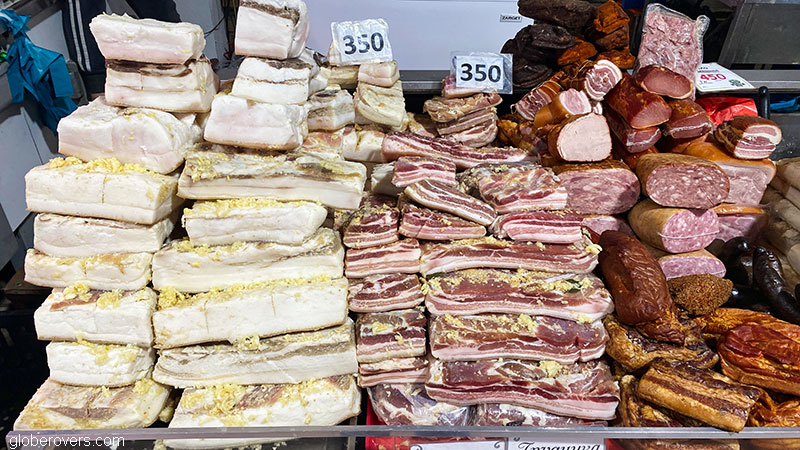
In addition to many kinds of fresh and packaged foods, the market has a good selection of clothing and accessories with most being imported from China and Mongolia. Even if you are not in the mood for buying anything, the market is a great place to see how the locals live their lives.

Gardens and Squares
At the centre of the historic part of the city is Speransky Square which lies inside Kirov Garden. The square has a long and interesting history. During the 17th and 18th centuries it was known as the Kremlin Square and was a bustling marketplace.
Today the Square is popular among the locals with its benches and a fountain. The fountain is the spot where the annual Christmas tree stands and where Maslenitsa (Pancake Week) is celebrated in March.
In winter, the entire park is adorned with ice sculptures as well as an ice-slide for the young at heart.

130 Kvartal
The city has been famous for its wooden buildings, although many have been demolished or destroyed by fires over the years. An area south of the historic centre, called 130 Kvartal, was rebuilt with traditional Siberian wooden houses transported here from locations throughout the country. Some buildings are less authentic but were purposely designed to blend in.
130 Kvartal is a pleasant area to stroll around and enjoy the architecture, restaurants, a modern shopping mall, cafés and shops, while pretending you are in 18th century southern Siberia.
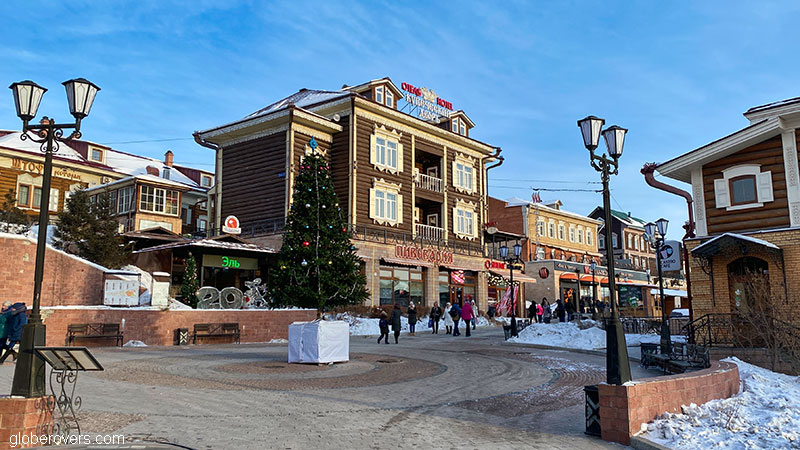
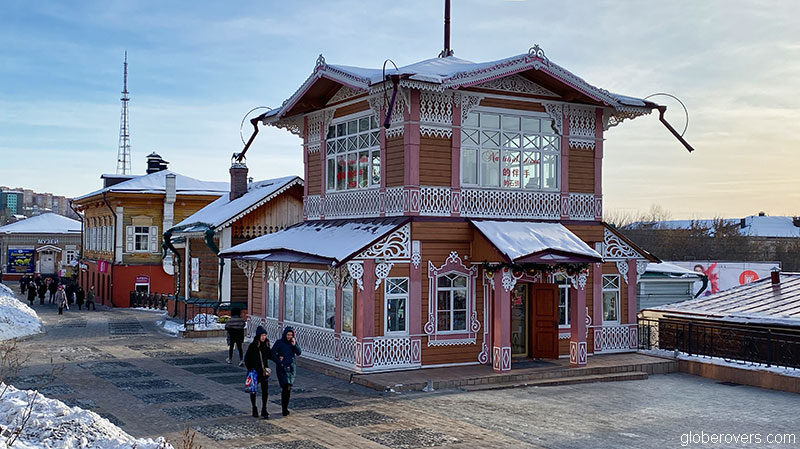
Guarding the northern entrance to 130 Kvartal on the square by Lenina street, is the large bronze statue of Babr (an old Russian word meaning ‘Siberian Tiger’).
The Babr symbol was outlawed during the Soviet era but to the delight of the locals it has been restored. Now you will find many versions of the Babr throughout the city and it is also featured on Irkutsk’s municipal coat of arms.

Statues and Monuments
With its Soviet past, the city has no shortage of statues and monuments. Adorning the Angara River’s western embankment at the end of Karl Marx Road, is a large statue of Alexander III, which is a metal recast of the 1904 original copper. Alexander III is celebrated here as the only tsar ever to visit Irkutsk.
Along the northern embankment, just across the street from the Bogoyavlensky Cathedral, is the statue of the city’s founder, Yakov Pokhabov.
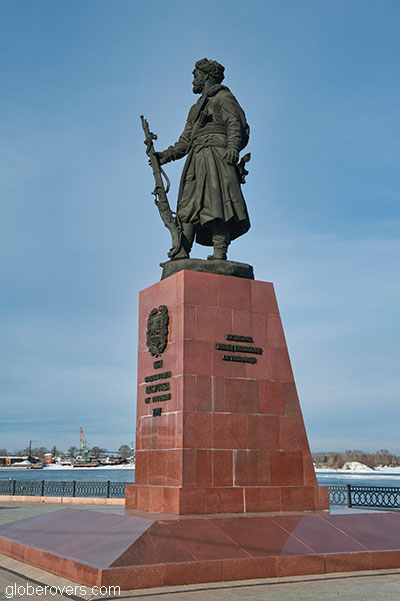
At the Znamensky Monastery is the statue of Admiral Kolchak who was executed by the Bolsheviks.
What would a Russian city be without a statue of Vladimir Lenin? Unveiled in 1952, you will find his statue at the intersection of Lenin and Karl Marx Streets, a short distance to the southwest of the Archangel Michael Church of Kharlampy.
Outside of Town
The islands of “Yunost” (Youth) and “Konny” (Equestrian) are located in the Angara River to the west of the city. Especially in summer, they offer pleasant areas for roller skating and cycling, and there is lots of space for picnics under the trees.
The open stage occasionally features musicians or hosts shows by street performers. The sports area is the place to play football or volleyball. The islands are connected by bridges to each other and with separate connections to the city.
The only surviving ship of the original icebreakers of Russia, the Angara, is docked at the wall of the Irkutsk Hydroelectric Power Station some eight kilometres (5 mi) south of the city’s historic centre.
The History of Navigation on Lake Baikal Museum opened in 1991 on the icebreaker. The exhibit shows models of the Baikal ships, historical photographs and documents relating to the Angara and navigation in the region.
Across the Angara River at the northern end of the historic centre is the nerpinary (sealarium). This is an ideal place, and maybe the only opportunity you will have, for a close encounter with the freshwater Baikal seal.
There is another sealarium at the southern tip of Listvyanka along the shores of Lake Baikal, some 70 kilometres (43 mi) south of Irkutsk.
Essential Information
Getting There
Irkutsk can be reached by either plane or train, or a long road trip. Planes fly into the town from a few Russian cities, as well as from several international cities across Asia.
Irkutsk lies along the Trans-Siberian train route, so it is easy to stop over before continuing the journey.
Getting Around
Public transport around the region is best by shared taxis and minivans. Book a day or two in advance and the minivan may even pick you up at your hotel. For a more convenient way of travel, and to reach the more remote destinations, renting a vehicle with a driver/guide is highly recommended.
In town, walk or take public transport which is easy enough. Taxis aboud. Use the Yandex Go App to book on your smartphone.
Photography
Irkutsk and the Baikal Region is photogenic, particularly in the middle of winter. Bring along a good prime lens to capture the delicate ice crystals, as well as a wide-angle lens to photograph the ice caves and the interiors of the domed churches. A polarized filter will help eliminate glare on the ice.
When to Go
The area is an all-year-round destination. Summers are warm for hiking, camping, and even swimming in the lake. Spring and autumn offer beautiful seasonal colours.
Winter is magical as the lake freezes over and turns into a winter delight.
Where to Stay
While towns such as Irkutsk and Ulan-Ude (and even Khuzhir on Olkhon Island) have several hotels and guesthouses that can be booked online via Agoda and Booking.com. For the smaller villages it is best to book via a local agency.
Safety
The safety risks in this region come mostly from the natural attractions, rather than people. The area is rugged and poses threats from animal attacks, as well as insects. Best to travel with a guide in the remote areas, particularly during the cold winter months.
Dining Out
The area is known for its excellent Russian and Siberian restaurants. For affordable dining in Irkutsk, visit Posnaya 38 restaurant north of the Angara Hotel and west of Kirov’s Park. Upscale dining is best at Rassol’nik Restaurant at the northern end of 130 Kvartal.
Train Travel
The Trans-Siberian train goes through Irkutsk so it is an alternative to arriving by plane or by ultra long-distance road travel.
Once in Irkutsk, train travel is limited to the Circum-Baikal Railway which runs for 89 km (55 mi) along the lake from near its southernmost point at Slyudyanka to Port Baikal at the mouth of the Angara River.
Cost of Travel
Getting here may be the biggest expense. The costs of local travel, food, and lodging are not outrageous. Tours are expensive if booked online prior to arrival. Best to shop around once you are in Irkutsk. Most destinations can be visited without a tour.
☛ Read more: Blog posts of Russia
☛ Read more: Frozen Lake Baikal in Winter
Book your travels around Lake Baikal with these excellent local operators: (Tell them GlobeRovers Magazine sent you!)
BAIKAL TERRA:
Contact Lida at terrabaikal@yandex.ru.
Website: baikalterra.com/en/
BAIKALER:
Contact Jack Sheremetoff at baikaler@gmail.com
Website: baikaler.com
BAIKAL TOUR:
Contact Denis Sobnakov at sobnakov@gmail.com
Website: baikaltour.net
ACCOMMODATION ON OLKHON ISLAND:
Nikita’s Homestead
Website: olkhon.info/en/manor-house/




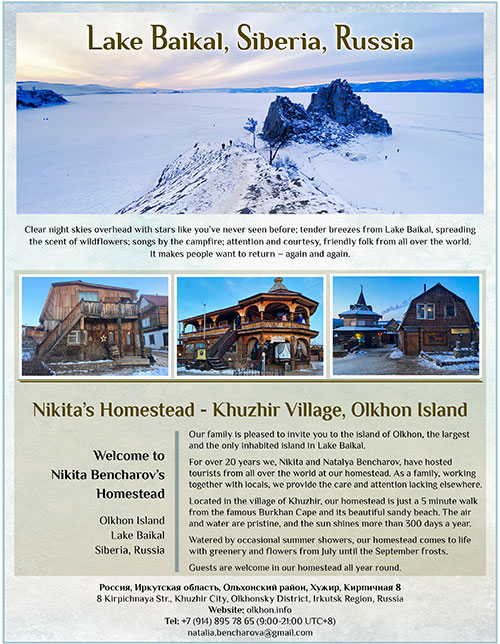

Blog post and photos by Peter who has been travelling almost full-time since 2005 and has been to over 122 countries. He visited several countries, such as Japan, more than 20 times. Peter is Editor-in-Chief and Publisher of GlobeRovers Magazine, an independent travel magazine focused on intrepid destinations.
